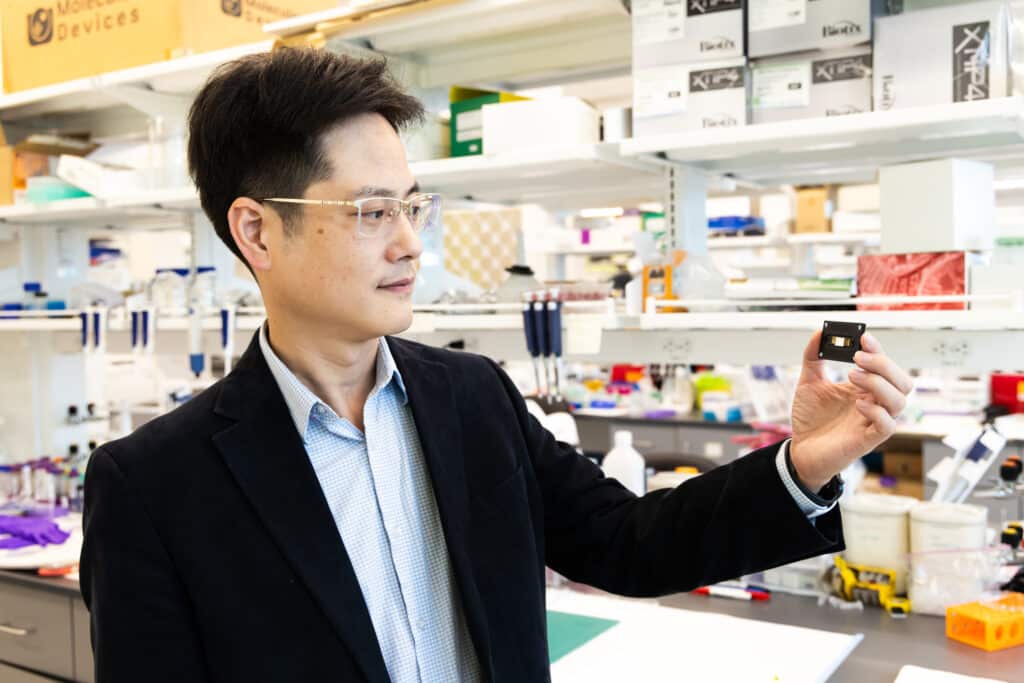Precision sensors: an innovative future for agriculture
At the North Carolina Plant Sciences Initiative, NC State researchers are advancing sensor technology to help farmers face challenges like emerging plant diseases and climate change.

In the summer of 2022, growers in North Carolina were alarmed to find a new variant of the Tomato Spotted Wilt Virus (TSWV). Transmitted by insects called thrips and resistant to existing treatments, TSWV is difficult to eliminate and can ruin an entire crop. With one of the widest ranges among plant diseases, it also infects peppers, tobacco, potatoes, eggplants, squashes, lettuce, onions, spinach and herbs like peppermint.
Diseases caused by pathogens like TSWV are only one of many challenges today’s farmers face as they navigate an industry with little room for error. Crops require time and ideal conditions to reach their peak for harvest. Finding an infection of TSWV too late is expensive, risking growers not only their entire crops but also the cost of resources and labor they’ve invested. Recouping costs even by next year’s harvest can be difficult.
“The earlier growers can identify plant diseases or fungal infections, the better able they will be to limit the spread of the disease and preserve their crop.”
These tough odds are one reason the North Carolina Plant Sciences Initiative (N.C. PSI), headquartered at NC State, is developing tools to help with a common conundrum: If growers had a way to detect a problem sooner, they could intervene before it becomes pervasive.
Researchers at N.C. PSI are innovating advanced sensor technology to aid in early detection. These smart sensors can detect diseases before visible signs appear, measure plant health more accurately and alert for harmful crop conditions — saving growers time and costly resources.
Using smart technology to conserve resources is also fundamental to N.C. PSI’s broader strategy and vision for an agricultural future that is resilient and sustainable.
Sensor Tech: Engineering for Plant Science

WolfSens, an ongoing N.C. PSI research project, has developed two sensors that can help growers facing challenges such as the blight-like effects of TSWV and similar pathogens.
“The earlier growers can identify plant diseases or fungal infections, the better able they will be to limit the spread of the disease and preserve their crop,” says Qingshan Wei, associate professor of chemical and biomolecular engineering and leader of the interdisciplinary WolfSens research team.
An ode to NC State’s mascot, WolfSens is also shorthand for “Wearable Olfactory Sensing.” These two advanced sensors can alert growers to the presence of disease by detecting — or ‘sniffing’ — the gasses plants naturally emit called volatile organic compounds, or VOCs. Farmers can determine which disease a plant has by measuring the type and concentration of VOCs the plant releases.

Wei and the WolfSens research team built a wearable electronic patch that provides continuous, real-time detection of a plant’s health. When attached to the underside of a leaf, the patches can detect the VOCs of viral and fungal infections. The patches can also alert growers of other stresses, such as overwatering, drought conditions, lack of light or high salt concentrations in irrigation water.
During tests, WolfSens researchers found the patch detected a viral infection in tomatoes more than a week before any symptoms of TSWV became visible.
The WolfSens team also created a portable sensor that uses a colorimetric strip of paper that measures VOCs and changes color depending on the presence of disease. The sensor utilizes a handheld device plugged into a smartphone, making it a convenient option for use in the field and greenhouses alike.
In proof-of-concept testing, the portable sensor detected and distinguished tomato late blight from two other important fungal pathogens that produce similar symptoms. In addition, the researchers showed they could detect the pathogen Phytophthora infestans in tomato leaves with greater than 95% accuracy.

Historically, testing plants for disease has been an invasive procedure that requires destroying crop tissues to get a sample. This process often requires hours or days in a lab, delaying disease identification by days or weeks.
Both sensors offer rapid responsiveness — providing farmers with the information they need to intervene quickly.
The WolfSens team created these two sensors to work together. The current versions of the patch and the portable strip sensor are designed for use in greenhouses with wireless internet access. Ultimately, WolfSens plans to develop the sensors to the point they could be used in outdoor fields, where farmers could apply them to a much wider variety of crops. Compared to the patch, the portable sensor — which works with any smartphone — could be priced lower and, therefore, even more attractive and accessible to farmers and growers of many different crops.

Another NC State researcher at N.C. PSI is also furthering sensor technology to help growers. Michael Kudenov, a professor of electrical and computer engineering, specializes in the application of light polarization, or the use of light waves for measuring biological structures. He and his team are exploring using polarized light in agriculture and have developed software to assist imaging sensors in overcoming the sun’s glare.
Sensors used in agriculture are typically programmed to determine a plant’s well-being based on the color of its leaves or stems. However, bright sunlight can distort the colors the sensors perceive, leading to an inaccurate determination of a plant’s health.
With Kudenov’s software, the imaging sensors can capture a plant’s color and measure how polarized the light is. The software’s algorithm estimates the true color of a leaf based on two variables: the color that the imaging sensor perceives and how polarized the darkest wavelength of light is in the image. Kudenov’s team has developed this algorithm to simplify the technology and use less computational power than previous tools.
“The software we’ve developed essentially acts like an incredibly dynamic pair of polarized sunglasses, able to account for whatever polarization challenges are present in order to accurately capture the color of a leaf, regardless of the glare,” says Daniel Krafft, a Ph.D. student at NC State who was first author of a paper published on the imaging sensor software research.
The N.C. Plant Sciences Initiative at NC State

Kudenov, Wei, and their research teams exemplify how expertise in disciplines outside of plant science empowers N.C. PSI to find bold, new solutions for agriculture.
Wei’s specialization in chemical and biomolecular engineering has influenced how his WolfSens sensors mimic human biology by ‘sniffing’ out certain diseases. Relatedly, humans can also exhale VOC gasses that could indicate the presence of lung cancer.
Similarly, Kudenov is developing ways that polarization — commonly used in human health applications — could aid agriculture. In biomedical imaging, polarized light is used to reveal tissue structure and can determine the presence of cancer. Using polarization to understand plant tissue and other structures is an area that hasn’t received much attention — and Kudenov’s interdisciplinary work aims to change that.
“By bringing together all those different skill sets, we aim to solve some of the complex challenges that we see in agriculture and the environment in North Carolina and have relevance nationally and internationally.”
At its core, N.C. PSI’s mission is about making efficient use of existing expertise and resources to envision what’s possible. The concept of N.C. PSI evolved from the College of Agriculture and Life Sciences’ innovative interdisciplinary research. However, after years of planning and discussion, a wide range of stakeholders — including university administrators, farmers, commodity group leaders, and agribusiness and agtech industry representatives — decided that an interdisciplinary research hub would best position North Carolina’s agricultural sector for the future.
N.C. PSI was created to better leverage what NC State already offered: a foundational land-grant commitment to agriculture, cutting-edge STEM research and interdisciplinary innovation.
“The approach that we’re taking here at the PSI is using data science — like artificial intelligence, machine learning, computer vision — and applying those new technologies to agriculture,“ says Adrian Percy, N.C. PSI’s executive director.
N.C. not only taps into the talent and resources from CALS and other STEM-focused colleges, such as the College of Engineering, College of Natural Resources and College of Sciences; it’s also attracted collaboration from further afield, including the Wilson College of Textiles and the College of Humanities and Social Sciences.
“By bringing together all those different skill sets, we aim to solve some of the complex challenges that we see in agriculture and the environment in North Carolina and have relevance nationally and internationally,” Percy says.
N.C. PSI is housed in the NC State University Plant Sciences Building, a state-of-the-art, multifaceted facility with flexible spaces, interdisciplinary labs and a rooftop greenhouse — an exceptional place for furthering plant sciences.
Additionally, its location at ‘Think and Do’ NC State on Centennial Campus makes N.C. PSI a place where research gets out of the lab and classroom — and comes alive in the real world.
“To ensure a vibrant future for agriculture, we need a more efficient, environmentally sustainable approach.”
N.C. PSI Extension Agents collaborate with farms and greenhouses across North Carolina to test the research hub’s cutting-edge technology. The Extension Agents make these collaborations possible by building strong relationships locally and across commodity groups ranging from Christmas trees to hogs, vineyards to turkeys, livestock feed to fisheries and much more.
The research center also builds robust collaborations with industry partners. N.C. PSI’s Innovation Hub hosts nine companies that build relationships with N.C. PSI-affiliated scientists — including students — as they pursue solutions to some of the world’s most pressing agricultural challenges.
In addition, N.C. PSI launched its startup company incubator in the Plant Sciences Building earlier this year. The incubator is currently home to two startups: Hoofprint Biome and Raleigh Biosciences. A program called Seed2Grow also supports entrepreneurship and commercialization by providing guidance to NC State research-based startups through the N.C. PSI Commercialization Council.
Precision Agriculture for the Future
The early detection of pathogens or other stressors gives growers a chance to literally nip a problem in the bud before it spreads. Addressing problems when they’re limited and more localized is also part of the larger strategy behind precision agriculture — an approach centering on the efficient usage of finite resources.
With precision farming, growers target the problem as soon as possible. Instead of spraying pesticides widely, farmers can apply them precisely when and where they are needed, which helps them improve their bottom line. Using prescribed amounts of pesticides and fertilizers also means fewer chemicals in water runoff, which empowers communities to better protect natural ecosystems and safeguard human health.
Smart sensors are part of the plan for precise agriculture — a ‘less is more’ approach to address increasingly finite resources.
Agriculture faces complex challenges: climate change, water shifts, emerging crop diseases and pests, and a rapidly growing population that demands more food from less farmland. These challenges don’t fit into disciplinary silos, which is why N.C. PSI takes an interdisciplinary approach — bringing the brightest minds in academia, government and industry together to work hand-in-hand with stakeholders to find innovative solutions.
“To ensure a vibrant future for agriculture, we need a more efficient, environmentally sustainable approach that is economically viable for growers,” Percy says. “That’s exactly what the PSI’s research, education and extension efforts are forging today.”
This post was originally published in NC State News.
- Categories:


